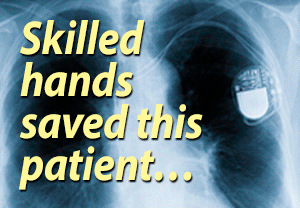 AMS hasn't switched back for 3 days
AMS hasn't switched back for 3 days
- by sgmfish
- 2022-04-09 11:21:16
- General Posting
- 901 views
- 6 comments
I've had my PM for a little over a year. All has gone pretty much as expected until 3 days ago (4/6/22). I have a finger pulse monitor I use from time to time. My base rate is set for 60 bpm, but I noticed my resting pulse suddenly always seemed to be 80 bps when I measured it. Some research enlightened me to the AMS system. Here are its parameters:
DDDR switches to DDIR; Trigger rate = 180; Base rate = 60; AMS base rate = 80
I've had 22 AMS episodes since 11/15/21 but they are all less than 1 or 2 minutes with the vast majority only lasting a few seconds. But on 4/6 I went into AMS mode, and as far as I can tell, I've not left it for 3 days. (I know when I am in AMS because my resting pulse in 80).
Does anyone know if this is something to be concerned about? A PM status and data report was issued on 4/7 after having been in AMS mode continuously for 24 hours. I have not received any calls from a monitring center or a doctor's office.
6 Comments
Automatic Mode Switch (AMS)
by Gemita - 2022-04-09 14:49:52
SGMFish,
You say a PM status and data report was issued on April 7th after being in AMS mode continuously for 24 hours. Have you had sight of this report to confirm what arrhythmia (if any?) triggered an AMS response and the highest heart rate recorded? From what you have told us, this is the longest lasting AMS period since November 15th 2021, so it would be significant from a duration point of view which if it continues, would mean that your arrhythmia (?AF/Flutter) is persisting and that you would need extra medication or other treatment to get you back into normal sinus rhythm. I see you have had an ablation for Atrial Flutter. Has Flutter returned, or has the ablation unmasked another arrhythmia like AF I wonder?
I have had a few thousand AMS episodes over a 12 month period for several years, but these are becoming less frequent and shorter lasting now. My AMS switches have reduced over the last three years from just under 3,000 AMS a year to around 900 a year today. I have many diagnosed atrial tachyarrhythmias as well as non sustained Ventricular tachycardia. My arrhythmias are well controlled and usually terminate without intervention but during an arrhythmia my pulse is far from steady and is certainly higher than your 80 bpm resting pulse? I have a rapid ventricular response rate when in AF.
My base rate is set at 70 bpm which is perfect for me during normal sinus rhythm. A resting pulse of 80 bpm would not necessarily worry me or my doctors, providing it didn’t increase to above 100 bpm (tachycardia) and stay above 100 bpm for long periods, although I can imagine if you are used to a low resting heart rate, 80 bpm will be uncomfortable. Apart from your uncomfortable 80 bpm resting rate, are you experiencing any other symptoms during your time spent in the non-atrial tracking mode DDIR?
I am paced AAI in normal sinus rhythm which switches to DDI when my arrhythmia exceeds a specific duration and speed. I don’t have my full AMS settings but my AMS onset rate is around 175 bpm and I certainly know when I switch from AAI to DDI and slide into AF. I am exceedingly symptomatic.
Further info
by sgmfish - 2022-04-09 17:34:58
Agent86....yep, I plan to call the EP office Monday when folks are in the office
Gemita.....Yes, I can download a PDF of the 13 or so page report almost immediately after it is created. I've looked at it in detail. I've educated myself fairly well on how to read it, but there is still much I don't understand (like the many 15 or 30 second EKG-like strips). Yeah, I figure my atrium must be going nuts, but the PM is keeping my ventricle pumping at 80 bps or higher depending on my activity. I presume I will need to go in a have an EKG done so they can figure out what's happening. The highest A rate on that "latst 24 hours" report was 640 bpm, and I can see in the strips mentioned above that my A rate is often about 320 bpm. Of course I have no way of knowing how much this varies over many hours, but I do know that every time I measure my resting pulse I get 80 bpm; so I figure that means I am always stuck in DDIR mode by the AMS system. BTW, I can't really feel anything so different except that I am more tired than usual, and get out of breath far more easily than I did a few days ago before all this started. My AT/AF Burden was 38% for the 24 hour period found in the report. Finally, my onset rate for AMS is set at 180. Al
I would get your AMS settings checked and ask for additional longer term monitoring for your arrhythmias
by Gemita - 2022-04-11 03:47:29
sgmfish, thank you for the update. From what you tell us I can see your atrial rates are hitting concerning levels. When mine reached these heights briefly, intermittently, I was very unstable. Even if these high atrial rates are only short in and out episodes, they could still trigger dangerous ventricular arrhythmias if not firmly controlled and I am rather surprised that your doctors have not contacted you or you have not become more symptomatic. I was certainly contacted by my clinic and told to take additional medication (Bisoprolol, Flecainide, Digoxin) at the time and told firmly to go to ER/A&E whenever I felt unstable.
An AT/AF burden in a 24 hour period of 38% is not insignificant and would concern me but a 38% burden doesn’t confirm your own findings, as you state, of being in “AMS mode” continuously for 3 days? I see they can adjust the AMS Base Rate setting for the duration we are in the non atrial tracking mode. I would perhaps respectfully ask whether the AMS settings are adjusted appropriately for you or whether your current settings are allowing you to remain in DDIR mode for longer periods in the absence of high heart rates? I would most definitely want better control over your arrhythmias since those intermittent high atrial rates you quoted are worrying. Please let us know what your doctors advise
AMS mode switching
by Selwyn - 2022-04-13 18:17:09
The AMS ( automatic mode switching) mode is triggered by excessive atrial activity and protects the ventricles from the atrial sensing picking up the activity and pacing your ventricles to death! Hence the change from DDDR to DDIR.(the I being inhibition of atrial or ventricular excessive activity). AMS is a safety device.
Our pacemakers count episodes of AMS and duration. ( The counter is usually reset to zero at the pacemaker check up).
Clearly, you are having atrial arrhythmias. You have noticed the increase in shortness of breath on exercise.
You should be anticoagulate, if possible..
Any NEW onset atrial arrhythmia of a duration of hours is to be treated as an emergency if not anticoagulated and rate controlled ( as cardioversion success is best when this is done as soon as possible). As for us 'old hands', a bit of atrial arrhythmia is OK provided the heart rate is acceptable. So, after Covid I had atrial flutter for 1 month . Heart rate did increase as I was in DDIR mode ( thanks to AMS). I was listed for another ablation - the flutter corrected itself. I had an episode of flutter last week lasting a few days, thanks to catching Covid again! (And I have had 4 vaccinations!!!!). There is a risk of stroke with atrial flutter or fibrillation if not anticoagulated. My AMS rate is about 80, my normal resting rate is set to 65.
Who wants atrial arrhythmias? No one. They reduce the efficiency of the heart. Perhaps not noticeable if you don't exercise. Last week I was left gasping after 2 lengths of the swimming baths ( my 6 lead Kardia ECG showed classic atrial flutter), This week I am fairly happy swimming a mile, though I still think Covid has not done my lungs much good.
I would be concerned to be anticoagulated, if possible ( or other procedures to prevent stroke)
I would be concerned to have my atrial arrhythmia prevented if possible (meds, or ablation).
An update
by sgmfish - 2022-04-15 13:14:45
Selwyn.....have no fear <grin>, I am fully "anticoagulatized".
Finally after 7 days, my PM is once again pacing my heart at a sitting rate of 60 bpm as opposed to the 80 bpm the PM has been pacing me at for the last week. I presume this means that the PM has decided to put me back into my normal DDDR mode instead of the DDIR mode I have been in for a week. I have no idea why mode switches and alerts have happened other than it;s supposed to happen in the event of high atrial tachycardia rates, but I seem to be doing fine. I feel pretty good, and have been able to do several hours of spring yard work during the last few days. I did contact my cardiologist office. It took them 3 days to respond; apparently they looked at the alert report when the AMS system kicked in. They have no real clue what's happening either; so they want me to do a blood test and then come in on 4/28 for an EKG and to see the cardioloist. However, I am due to have my 1 year EP and PM tech appointment anyway, so I think I will do that first, and then go to the cardiologist. My guess is that in the typical situation the person who knows the most about how a PM really works is the PM tech who works in my EP office, and then in this order after that: the PA in the EP office; the EP; and last, the cardiologist. So I'm going to try to see them in that order.
You know you're wired when...
Like the Energizer Bunny, you keep going.
Member Quotes
Think positive and go out and take on the world.

.png)



AMS mode
by AgentX86 - 2022-04-09 11:42:02
Maybe send a manual report to get someone's attention? Call your device tech or EP?